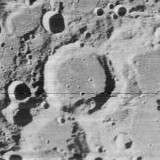Regnault (crater)
Regnault is a lunar impact crater that is located close to the northwest limb of the Moon. It lies across the western rim of the walled plain Volta, with the slightly smaller crater Stokes attached to the southern outer rim. Due to its location, Regnault is not favorably placed for viewing from the Earth. It is seen at a very oblique angle, limiting the detail that can be viewed. The visibility of this crater is also affected by libration of the Moon.
 Oblique Lunar Orbiter 4 image | |
| Coordinates | 54.1°N 88.0°W |
|---|---|
| Diameter | 47 km |
| Depth | Unknown |
| Colongitude | 88° at sunrise |
| Eponym | Henri V. Regnault |
As the eastern rim of Regnault lies across the rim of Volta, that eastern rim is somewhat less prominent than the western half. The rim has not been heavily eroded, although a small craterlet lies across the northern rim. Where it joins Stokes to the south, the rim has been straightened slightly, and ejecta lies across part of the interior floor. The inner walls of Regnault are relatively simple slopes that lead down to the level interior floor. This base is marked only by a few tiny craters and has no central peak.
Satellite craters
By convention these features are identified on lunar maps by placing the letter on the side of the crater midpoint that is closest to Regnault.
| Regnault | Latitude | Longitude | Diameter |
|---|---|---|---|
| C | 55.2° N | 89.2° W | 14 km |
| W | 53.5° N | 89.9° W | 15 km |
References
- Andersson, L. E.; Whitaker, E. A. (1982). NASA Catalogue of Lunar Nomenclature. NASA RP-1097.CS1 maint: ref=harv (link)
- Blue, Jennifer (July 25, 2007). "Gazetteer of Planetary Nomenclature". USGS. Retrieved 2007-08-05.CS1 maint: ref=harv (link)
- Bussey, B.; Spudis, P. (2004). The Clementine Atlas of the Moon. New York: Cambridge University Press. ISBN 978-0-521-81528-4.CS1 maint: ref=harv (link)
- Cocks, Elijah E.; Cocks, Josiah C. (1995). Who's Who on the Moon: A Biographical Dictionary of Lunar Nomenclature. Tudor Publishers. ISBN 978-0-936389-27-1.CS1 maint: ref=harv (link)
- McDowell, Jonathan (July 15, 2007). "Lunar Nomenclature". Jonathan's Space Report. Retrieved 2007-10-24.CS1 maint: ref=harv (link)
- Menzel, D. H.; Minnaert, M.; Levin, B.; Dollfus, A.; Bell, B. (1971). "Report on Lunar Nomenclature by the Working Group of Commission 17 of the IAU". Space Science Reviews. 12 (2): 136–186. Bibcode:1971SSRv...12..136M. doi:10.1007/BF00171763.CS1 maint: ref=harv (link)
- Moore, Patrick (2001). On the Moon. Sterling Publishing Co. ISBN 978-0-304-35469-6.CS1 maint: ref=harv (link)
- Price, Fred W. (1988). The Moon Observer's Handbook. Cambridge University Press. ISBN 978-0-521-33500-3.CS1 maint: ref=harv (link)
- Rükl, Antonín (1990). Atlas of the Moon. Kalmbach Books. ISBN 978-0-913135-17-4.CS1 maint: ref=harv (link)
- Webb, Rev. T. W. (1962). Celestial Objects for Common Telescopes (6th revised ed.). Dover. ISBN 978-0-486-20917-3.CS1 maint: ref=harv (link)
- Whitaker, Ewen A. (1999). Mapping and Naming the Moon. Cambridge University Press. ISBN 978-0-521-62248-6.CS1 maint: ref=harv (link)
- Wlasuk, Peter T. (2000). Observing the Moon. Springer. ISBN 978-1-85233-193-1.CS1 maint: ref=harv (link)